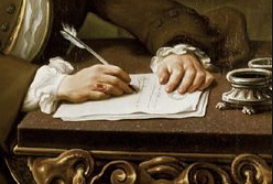Weak and Flighty - The Sentencing of John Wisner
Yesterday we saw the Continental Army’s disastrous attempt to attack Montresor’s Island in September of 1776.
A major problem with this invasion was that several Officers panicked and turned back.
Today we will look at the man who took the brunt of the blame for this, Captain John Wisner, and the punishment which was sought for his actions.
“I am extremely sorry for Wisner. I tho’t him weak & flighty, but I really tho’t he would fight”
-John McKesson to George Clinton, 9/29/1776
John Wisner
John Wisner was from a prestigious Revolutionary family about 80 miles north of New York City. They were involved with milling powder for the soldiers and his uncle, Henry Wisner, voted for independence at the Continental Congress (though he returned home before the actual signing took place).
Following in these footsteps, young John joined the Continental Army to fight for freedom.
There was one problem, however. John Wisner did not have the courage of a soldier.
The Time Arrives
Wisner spent the early part of the Revolutionary War providing guard duty, mostly at Fort Constitution.
Due to his family connections, John had been named Captain. This Officer rank meant that, when the time came, he would be expected to lead men.
That time arrived just before midnight on September 22, 1776.
In a hastily planned mission, Major General William Heath roused his men from their beds in secret and sent them to attack Montresor’s Island by boat.
This is when things began to unravel.
The Fear
Almost immediately after setting off, Wisner was found crouched down in the bottom of his boat.
Another Captain on board roused him and attempted to get him in a fighting spirit. In response, John claimed that the target was much more well manned than they were told, implying this was a suicide mission.
As they neared the island, Wisner again began to hide.
The other Captain, James Eldridge, began kicking John in an effort to get him ready for the engagement.
Unfortunately, it was too late. Then men on the boat, having heard this entire exchange, were now fearful that they were being led to the slaughter. They too began to duck and cover.
So much chaos and disorder had erupted that the men leading the vessel came to the conclusion that they needed to turn back. This was done, leaving the lead boat all alone on the island.
Court Martial
In the aftermath of the retreat, John Wisner was given a court martial for ‘Cowardice and Misbehaviour.’
He was convicted and cashiered (removed) from the Continental Army.
To some, this punishment was not harsh enough. General Washington, for instance, wanted Wisner hung. The Commander-in-Chief even communicated these feelings to the men who oversaw the court martial and asked them to reconsider. It was his opinion that the loss of life which resulted from John’s decisions was the ultimate crime of an Officer.
In response, the Judges informed Washington that the decision to spare Wisner’s life was made because the only evidence provided was hearsay. Since the men who were bearing witness against Wisner could also have been accused of the same crimes, there was always a chance they were throwing the blame at John in an effort to clear their own names.
Want to read about more Founders who received a court martial?
Check out these articles:
Adam Steven Gets Blamed for Germantown
John Sullivan - Accidental Diplomat
William Maxwell Commands While Disguised With Liquor
Perhaps the most interesting (yet forgotten) court martial was that of famous rider Paul Revere.
‘The Court Martial of Paul Revere’ tells the story of his military disaster at Penobscot Bay.
If you’d like a copy you can get one through the Amazon affiliate link below (you’ll support this site, but don’t worry, Amazon pays me while your price stays the same).
Want to get fun American Revolution articles straight to your inbox every morning?
Subscribe to my email list here.
You can also support this site on Patreon by clicking here.






